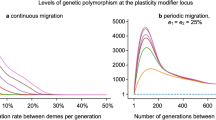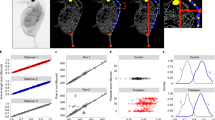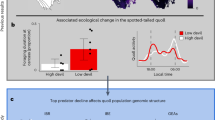Abstract
Phenotypic plasticity is the ability of an individual genotype to alter aspects of its phenotype depending on the current environment. It is central to the persistence, resistance and resilience of populations facing variation in physical or biological factors. Genetic variation in plasticity is pervasive, which suggests its local adaptation is plausible. Existing studies on the adaptation of plasticity typically focus on single traits and a few populations, while theory about interactions among genes (for example, pleiotropy) suggests that a multi-trait, landscape scale (for example, multiple populations) perspective is required. We present data from a landscape scale, replicated, multi-trait experiment using a classic predator–prey system centred on the water flea Daphnia pulex. We find predator regime-driven differences in genetic variation of multivariate plasticity. These differences are associated with strong divergent selection linked to a predation regime. Our findings are evidence for local adaptation of plasticity, suggesting that responses of populations to environmental variation depend on the conditions in which they evolved in the past.
This is a preview of subscription content, access via your institution
Access options
Access Nature and 54 other Nature Portfolio journals
Get Nature+, our best-value online-access subscription
$29.99 / 30 days
cancel any time
Subscribe to this journal
Receive 12 digital issues and online access to articles
$119.00 per year
only $9.92 per issue
Buy this article
- Purchase on Springer Link
- Instant access to full article PDF
Prices may be subject to local taxes which are calculated during checkout



Similar content being viewed by others
References
Tollrian, R. & Harvell, C. D. The Ecology and Evolution of Inducible Defenses (Princeton Univ. Press, Princeton, 1999).
Miner, B. G., Sultan, S. E., Morgan, S. G., Padilla, D. K. & Relyea, R. A. Ecological consequences of phenotypic plasticity. Trends Ecol. Evol. 20, 685–692 (2005).
Pfennig, D. W. et al. Phenotypic plasticity’s impacts on diversification and speciation. Trends Ecol. Evol. 25, 459–467 (2010).
Chevin, L.-M., Lande, R. & Mace, G. M. Adaptation, plasticity, and extinction in a changing environment: towards a predictive theory. PLoS Biol. 8, e1000357 (2010).
Draghi, J. A. & Whitlock, M. C. Phenotypic plasticity facilitates mutational variance, genetic variance, and evolvability along the major axis of environmental variation. Evolution 66, 2891–2902 (2012).
Ghalambor, C. K. et al. Non-adaptive plasticity potentiates rapid adaptive evolution of gene expression in nature. Nature 525, 372–375 (2015).
Ghalambor, C. K., McKay, J. K., Carroll, S. P. & Reznick, D. N. Adaptive versus non-adaptive phenotypic plasticity and the potential for contemporary adaptation in new environments. Funct. Ecol. 21, 394–407 (2007).
Hendry, A. P. Key questions on the role of phenotypic plasticity in eco-evolutionary dynamics. J. Hered. 107, 25–41 (2016).
Pigliucci, M. Evolution of phenotypic plasticity: where are we going now? Trends Ecol. Evol. 20, 481–486 (2005).
Via, S. & Lande, R. Genotype–environment interaction and the evolution of phenotypic plasticity. Evolution 39, 505–522 (1985).
Lind, M. I., Yarlett, K., Reger, J., Carter, M. J. & Beckerman, A. P. The alignment between phenotypic plasticity, the major axis of genetic variation and the response to selection. Proc. R. Soc. B 282, 20151651 (2015).
Merilä, J. & Hendry, A. P. Climate change, adaptation, and phenotypic plasticity: the problem and the evidence. Evol. Appl. 7, 1–14 (2014).
Taylor, B. E. & Gabriel, W. To grow or not to grow—optimal resource-allocation for Daphnia. Am. Nat. 139, 248–266 (1992).
Tollrian, R. Predator-induced morphological defenses—costs, life-history shifts, and maternal effects in Daphnia pulex. Ecology 76, 1691–1705 (1995).
Reznick, D. & Endler, J. A. The impact of predation on life-history evolution in Trinidadian guppies (Poecilia reticulata). Evolution 36, 160–177 (1982).
Riessen, H. P. Predator-induced life history shifts in Daphnia: a synthesis of studies using meta-analysis. Can. J. Fish. Aquat. Sci. 56, 2487–2494 (1999).
De Meester, L. & Weider, L. J. Depth selection behavior, fish kairomones, and the life histories of Daphnia hyalina × galeata hybrid clones. Limnol. Oceanogr. 44, 1248–1258 (1999).
Tollrian, R. & Dodson, S. I. in The Ecology and Evolution of Inducible Defenses (eds Tollrian, R. & Harvell, C. D.) 177–202 (Princeton Univ. Press, Princeton, 1999).
Tollrian, R. Neckteeth formation in Daphnia pulex as an example of continuous phenotypic plasticity—morphological effects of Chaoborus kairomone concentration and their quantification. J. Plankton Res. 15, 1309–1318 (1993).
Dennis, S. R., Carter, M. J., Hentley, W. T. & Beckerman, A. P. Phenotypic convergence along a gradient of predation risk. Proc. R. Soc. B 278, 1687–1969 (2011).
Robinson, M. R. & Beckerman, A. P. Quantifying multivariate plasticity: genetic variation in resource acquisition drives plasticity in resource allocation to components of life history. Ecol. Lett. 16, 281–290 (2013).
Calsbeek, B. & Goodnight, C. J. Empirical comparison of G matrix test statistics: finding biologically relevant change. Evolution 63, 2627–2635 (2009).
Karhunen, M., Merilä, J., Leinonen, T., Cano, J. M. & Ovaskainen, O. DRIFTSEL: an R package for detecting signals of natural selection in quantitative traits. Mol. Ecol. Resour. 13, 746–754 (2013).
Karhunen, M. & Ovaskainen, O. Estimating population-level coancestry coefficients by an admixture F model. Genetics 192, 609–617 (2012).
Karhunen, M., Ovaskainen, O., Herczeg, G. & Merila, J. Bringing habitat information into statistical tests of local adaptation in quantitative traits: a case study of nine-spined sticklebacks. Evolution 68, 559–568 (2014).
Ovaskainen, O., Karhunen, M., Zheng, C., Arias, J. M. & Merilä, J. A new method to uncover signatures of divergent and stabilizing selection in quantitative traits. Genetics 189, 621–632 (2011).
Lynch, M. et al. The quantitative and molecular genetic architecture of a subdivided species. Evolution 53, 100–110 (1999).
Reznick, D. The impact of predation on life history evolution in Trinidadian guppies: genetic basis of observed life history patterns. Evolution 36, 1236–1250 (1982).
Schmid, M. & Guillaume, F. The role of phenotypic plasticity on population differentiation. Heredity 119, 214–225 (2017).
Hendry, A. P., Day, T. & Taylor, E. B. Population mixing and the adaptive divergence of quantitative traits in discrete populations: a theoretical framework for empirical tests. Evolution 55, 459–466 (2001).
Hine, E., Chenoweth, S. F., Rundle, H. D. & Blows, M. W. Characterizing the evolution of genetic variance using genetic covariance tensors. Phil. Trans. R. Soc. B 364, 1567–1578 (2009).
Aguirre, J. D., Hine, E., McGuigan, K. & Blows, M. W. Comparing G: multivariate analysis of genetic variation in multiple populations. Heredity 112, 21–29 (2014).
Delahaie, B. et al. Conserved G-matrices of morphological and life-history traits among continental and island blue tit populations. Heredity 119, 76–87 (2017).
Gienapp, P. et al. Predicting demographically sustainable rates of adaptation: can great tit breeding time keep pace with climate change? Phil. Trans. R. Soc. B 368, 20120289 (2013).
Chevin, L. M. & Lande, R. When do adaptive plasticity and genetic evolution prevent extinction of a density-regulated population? Evolution 64, 1143–1150 (2010).
Tollrian, R. & Dodson, S. in The Ecology and Evolution of Inducible Defenses (eds Tollrian, R. & Harvell, C. D.) 177–202 (Princeton Univ. Press, Princeton, 1999).
Hammill, E., Rogers, A. & Beckerman, A. P. Costs, benefits and the evolution of inducible defences: a case study with Daphnia pulex. J. Evol. Biol. 21, 705–715 (2008).
Stibor, H. Predator induced life-history shifts in a freshwater cladoceran. Oecologia 92, 162–165 (1992).
Weider, L. & Pijanowska, J. Plasticity of Daphnia life histories in response to chemical cues from predators. Oikos 67, 385–392 (1993).
Parejko, K. & Dodson, S. I. The evolutionary ecology of an antipredator reaction norm: Daphnia pulex and Chaoborus americanus. Evolution 45, 1665–1674 (1991).
Spitze, K. Chaoborus predation and life-history evolution in Daphnia pulex: temporal pattern of population diversity, fitness, and mean life history. Evolution 45, 82–92 (1991).
Spitze, K. Predator-mediated plasticity of prey life history and morphology: Chaoborus americanus predation on Daphnia pulex. Am. Nat. 139, 229–247 (1992).
Beckerman, A. P., Rodgers, G. M. & Dennis, S. R. The reaction norm of size and age at maturity under multiple predator risk. J. Anim. Ecol. 79, 1069–1076 (2010).
Tollrian, R. Chaoborus crystallinus predation on Daphnia pulex: can induced morphological changes balance effects of body size on vulnerability? Oecologia 101, 151–155 (1995).
Cristescu, M. E., Colbourne, J. K., Radivojac, J. & Lynch, M. A microsatellite-based genetic linkage map of the waterflea, Daphnia pulex: on the prospect of crustacean genomics. Genomics 88, 415–430 (2006).
Reger, J. The Quantitative Genetic Basis of Inducible Defences and Life-History Plasticity in Daphnia pulex. PhD thesis, Univ. Sheffield (2013).
Kenta, T. et al. Multiplex SNP-SCALE: a cost-effective medium-throughput single nucleotide polymorphism genotyping method. Mol. Ecol. Res. 8, 1230–1238 (2008).
R Development Core Team R: A Language and Environment for Statistical Computing (R Foundation for Statistical Computing, Vienna, 2016).
Hadfield, J. D. MCMC methods for multi-response generalized linear mixed models: the MCMCglmm R package. J. Stat. Softw. 33, 1–22 (2010).
Ovaskainen, O., Cano, J. M. & Merila, J. A Bayesian framework for comparative quantitative genetics. Proc. R. Soc. B 275, 669–678 (2008).
Acknowledgements
We thank S.R. Dennis, J. Slate and A. Bergland for constructive comments and discussion. M. Karhunen provided statistical advice and code support. J.R. was supported by a Natural Environment Research Council CASE PhD with support from the Freshwater Biological Association. M.I.L. was supported by the Swedish Research Council (623-2010-848). M.R.R. was supported by a Natural Environment Research Council early-career fellowship (NE/G013535/1) and is currently supported by the University of Lausanne. A.P.B. was supported by a Natural Environment Research Council standard grant (NE/D012244/1) and the University of Sheffield.
Author information
Authors and Affiliations
Contributions
J.R. and A.P.B. designed the research. J.R. and M.I.L. collected the data. A.P.B. and M.R.R. developed the methods. J.R., A.P.B., M.R.R. and M.I.L. analysed the data and wrote the paper.
Corresponding author
Ethics declarations
Competing interests
The authors declare no competing financial interests.
Additional information
Publisher’s note: Springer Nature remains neutral with regard to jurisdictional claims in published maps and institutional affiliations.
Electronic supplementary material
Supplementary Information
Supplementary figures 1–4; supplementary tables 1–2.
Rights and permissions
About this article
Cite this article
Reger, J., Lind, M.I., Robinson, M.R. et al. Predation drives local adaptation of phenotypic plasticity. Nat Ecol Evol 2, 100–107 (2018). https://doi.org/10.1038/s41559-017-0373-6
Received:
Accepted:
Published:
Issue Date:
DOI: https://doi.org/10.1038/s41559-017-0373-6
This article is cited by
-
Adaptive phenotypic plasticity is under stabilizing selection in Daphnia
Nature Ecology & Evolution (2022)
-
Do omnivorous black bullhead (Ameiurus melas) and planktivorous common bleak (Alburnus alburnus) elicit different inducible defences in Daphnia magna?
Hydrobiologia (2022)
-
Effect of environmental history on the habitat-forming kelp Macrocystis pyrifera responses to ocean acidification and warming: a physiological and molecular approach
Scientific Reports (2021)
-
Raised by aliens: constant exposure to an invasive predator triggers morphological but not behavioural plasticity in a threatened species tadpoles
Biological Invasions (2021)
-
Natural selection on traits and trait plasticity in Arabidopsis thaliana varies across competitive environments
Scientific Reports (2020)




